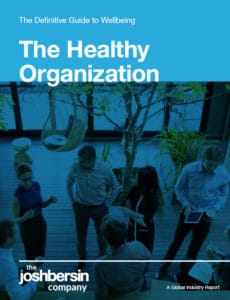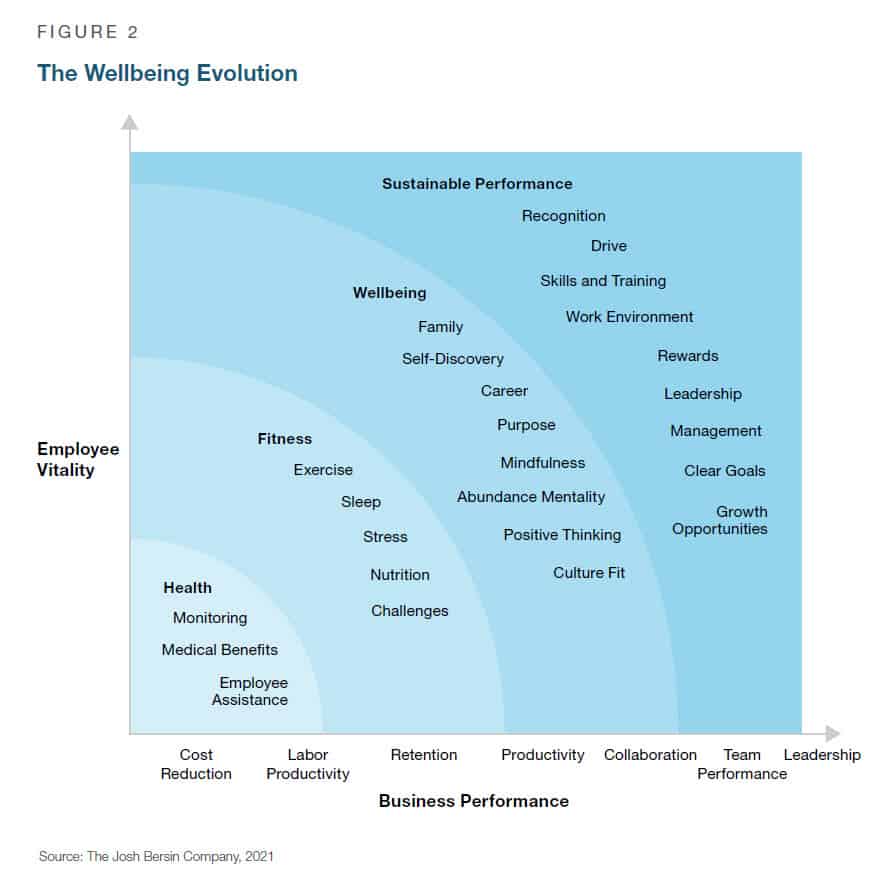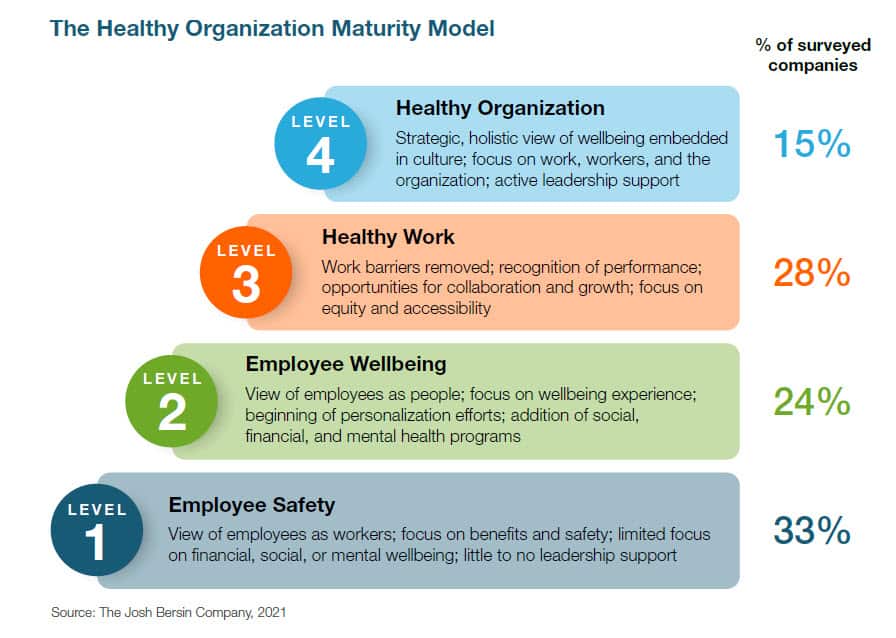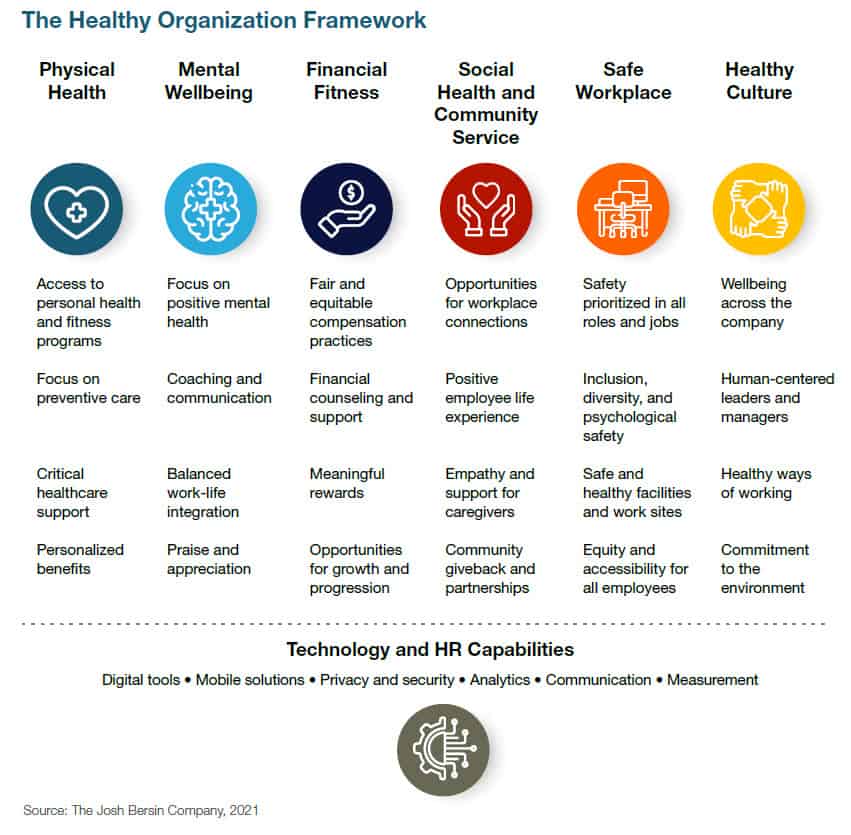The Healthy Organization: Next Big Thing In Employee Wellbeing
This week we’re launching a year-long research effort we call The Healthy Organization, which brings together almost everything we’ve been talking about since the start of the pandemic. Let me explain what we’ve discovered, and in this “long read” column I’ll bring it all into perspective. (News release here.)
 The Pandemic’s Impact on Wellbeing
The Pandemic’s Impact on Wellbeing
As you know well, the Pandemic has taken us from a state of shock and fear to one of uncertainty, fatigue, and frustration. After nearly two years of response, we are left with an economy that is “partially open,” an ever-changing set of policies for vaccines and masking, and a growing sense of fatigue from remote and hybrid work.
And today, like never before in my lifetime, almost two-thirds of companies are worried about the mental and behavioral health of their employees. So companies are investing in psychologists, resilience tools, mindfulness, and many flexible work benefits to help people recover.
But this didn’t all just start with COVID-19. For many years prior companies were struggling to help employees with what I called “The Overwhelmed Employee.” We complained about too many emails, not enough sleep, and the never-ending stream of messages, meetings, notifications, and interruptions at work. An entire $60 Billion industry of wacky employee wellbeing programs was created (they’re not really wacky, but they are awfully strange) to help people feel better at work.
Prior to the pandemic we did lots of research on these programs (our JBA Program Wellbeing at Work details the practices) and what I found was an ever-escalating war for perks, benefits, and slightly strange programs (egg harvesting, unlimited vacation, real-time pay) in an effort to attract and support employees. We had yoga classes at work, mindfulness training, and the entire management team started to worry about sleep, exercise, and fitness.
And the tech industry, never one to miss an opportunity, responded in force. Tools like League, VirginPulse, Limeade, BetterUp, SpringHealth, and hundreds of other companies were flooded with venture capital and private equity, creating a cyclone of innovation in this market. Often these tools don’t add as much value as people think, but companies are gobbling them up regardless. It’s just “the right thing to do.”
We interviewed hundreds of companies and often heard the same thing. These Wellbeing programs were acquired by the benefits department, and most of them were “kind of working” but too valuable to stop buying. I talked with the head of Wellbeing at Salesforce and she told me they had more than 120 such programs, each of which was highly valued by some segment of employees. Deloitte had over 90 different wellbeing benefits when I left, and most consultants didn’t know what they were.
Recognizing this problem, many employers have turned to navigation solutions. Navigation solutions like the ones offered by Castlight provide a single point of entry for employees to effectively engage in their health benefits and wellbeing programs.
 |
I sensed, at the time, that this market was a bit ahead of itself, so we guessed that all this would change. And we were largely correct: these perks, apps, and benefits evolved, and the Pandemic put them in the right place. Today, as we look at the tight labor market, endless worries about the virus and travel, and all sorts of stress induced by economic growth, companies are moving ahead. And they’re evolving to a model we call “The Healthy Organization.”
Evolution Of Wellbeing To The Healthy Organization
We have had hundreds of hours of meetings with CHROs and other HR leaders and they all say the same thing. We need programs and solutions that help everyone in the company be healthy, and they have to go far beyond wellbeing. They want leaders to give people more flexibility. They want employees to feel empowered and well trained. And they want the organization as a whole to embrace productivity, growth, and long-term sustainability.
We call this evolution the shift from Wellbeing as a benefit to a focus on The Healthy Organization. And our research shows how this works.
 |
Level 1: Employee Safety
At the bottom level of maturity, companies focus on safety, a program that’s highly strategic in many industries. When I worked in the oil industry, we had to wear Nomex coveralls, hard-hat, and goggles in the refinery. It was a mandatory part of our work. Companies like Dow Chemical, Chevron, Cemex, and many others rank safety as their top priority. And this makes sense.
As Maslow’s hierarchy points out, when people don’t feel safe, nothing else can really happen. So at its core, a Healthy Organization is safe. Today safety has many meanings: physical safety is paramount, but so is psychological safety, safety to be yourself, and safety to take a break, rest, or slow down.
In the pandemic we all needed masks, vaccines, testing, and a safe workplace. But we also need psychological safety to speak up and ask questions, social safety to be quiet or show up late, and leadership safety to feel included, respected, and heard. All these matters, and as you can see, roughly a third of companies heavily focus in this area.
Level 2: Employee Wellbeing
At the next level of investment, companies built Wellbeing programs. And this is where most companies are. Every CHRO and CEO now has a Wellbeing strategy, and in many organizations (JP Morgan Chase, Workday) there are Wellbeing ambassadors, business partners, and specialists around the world.
The Wellbeing “program” is often run out of the benefits department, and it includes dozens or hundreds of programs, benefits, and healthcare offerings. Vendors like Gympass offer a wide range of fitness, mental health, and resilience programs (costing up to $500 per month per employee), and tools like Mequilibrium or Limeade offer resilience check-ins, education, and online assessments. Today nearly every large company has a whole constellation of these programs, and they are expensive, complex, and highly valued.
We’ve developed a whole research report on the offerings, and there are literally thousands of solutions available. Our research shows that they do add great value, but many serve more as recruiting tools than actual work improvement offerings. Nevertheless, this industry has been healthy, and while it may be a bit oversold in some areas, most companies love these programs.
But as the Pandemic wore on, companies told us they needed more. No tools or apps can help meetings be more productive, so we move to level 3: a focus on healthy work.
Level 3: Healthy Work
In our Irresistible Organization research (The Definitive Guide to Employee Experience), we found that “work design” and “management practices” are among the most important parts of health. When people feel they have the right tools, resources, and time, they feel relaxed and productive on the job. And this comes up constantly as we talk with wellbeing managers.
Let me give you an example. Last week I talked with the CHRO of one of the largest healthcare providers in Idaho. They are flooded with COVID cases and have tremendous workload challenges, patient behavior problems, and difficulty hiring people. She told me “we have lots of wellbeing programs, nap rooms, and benefits but people keep saying when will I get time to do this stuff?”
Janet Mertens, our Research Director who led this research, told me that clients keep saying “despite all the benefits and programs we offer, employees keep telling us we don’t think you really care.” And that is the essence of level 3. At this point you have to ask yourself: are we giving people too much to do? Are we working too many hours? Are we really making goals clear? And are we recognizing and rewarding people in a fair and collaborative way?
As you can see from the research, about a quarter of companies focus on this area – and this means 75% do not. I’d suggest if you rethink Wellbeing as part of your organizational health strategy, you’ll bring this into focus.
Level 4: Healthy Organization
At level 4 organizations go beyond. Here companies look at the leadership model, opportunities to grow, and the company’s overall health from top to bottom. A large CPG company, for example, looks at employee retention, mobility, and engagement across all brands, and can tell when one brand is falling behind. These indicators show management that they need to look at many areas of the employee experience, and they annually benchmark themselves against each other.
 |
An Example Of The Four Levels
Imagine you are Amazon.com or another retail distribution company. The four levels may be interpreted as follows:
Level 1: Safety. Are the trucks safe? Are the tires and vehicles maintained? Do employees wear back braces? Are packages stored in a safe way?
Level 2: Employee wellbeing. Are the seats and driving conditions comfortable? Are employees fit and rested? Do people have enough breaks?
Level 3: Healthy work. Are the schedules flexible? Can people finish their shifts without speeding? Are there adequate traffic tools to travel productively?
Level 4: Healthy organization. Can drivers and logistics workers get promoted? Do they feel engaged with the company’s mission? Are they trained to grow and interact with customers in a positive way? Do people help each other when there are weather or logistics emergencies?
Why Does Level 4 Matter?
Companies now spend up to 32% of all payroll on non-cash benefits, insurance, and perks. How do we make sure this enormous budget (hundreds of billions) pays off?
Well, we carefully looked at the financial returns, human capital measures, and growth and innovation measures of our research sample. And we did find that companies at Level 3 and 4 far outperform their peers. While they do spend much more money on health and wellbeing, their results are extraordinarily better. These companies are almost 11 times more likely to have low levels of absenteeism, 220% more likely to be meeting their financial targets, twice as likely to be “great places to work” and 540% more effective at recruiting top people.
But it’s even more interesting than that. Companies that scored at level 4 (the top 15% of our sample), were almost four times more likely to be market leaders and financially top performers in their industry. So the impact of moving from level 3 to level 4 is massive.
What does this mean? It clearly tells us that we’ve moved beyond “wellbeing as a strategy” and now you should think about becoming a totally “Healthy Organization.”
Additional Resources
If you’d like to learn more, listen to the podcast I just published today and join our Big Reset research group. The research is available at no charge and we soon offer an online diagnostic so you can see where your company fits, strategy guides for your team, and consulting to help you realign your organization’s priorities.
As the pandemic continues and we all compete for talent, becoming a Healthy Organization is more important than ever. Join us.
Even More Resources
The Secret To Wellbeing At Work… is Leadership
The Joys Of Hybrid Work: Ten Things We’ve Learned


